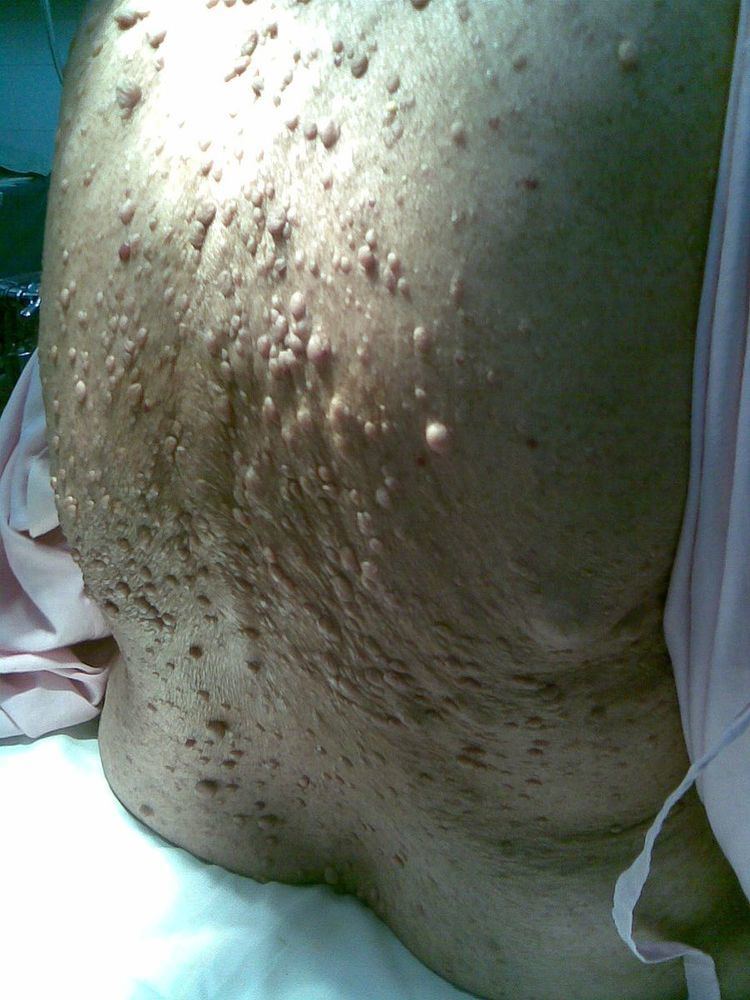Duration Life long | ||
 | ||
Usual onset Birth to early adulthood Diagnostic method Symptoms, genetic testing | ||
Neurofibromatosis (NF) is a group of three conditions in which tumors grow in the nervous system. The three types are neurofibromatosis type 1 (NF1), neurofibromatosis type 2 (NF2), and schwannomatosis. In NF1 symptoms include light brown spots on the skin, freckles in the armpit and groin, small bumps within nerves, and scoliosis. In NF2 there may be hearing loss, cataracts at a young age, balance problems, flesh colored skin flaps, and muscle wasting. The tumors are generally non cancerous.
Contents
- Signs and symptoms
- Cause
- Pathophysiology
- Diagnosis
- Differential diagnosis
- Treatment
- Prognosis
- Epidemiology
- References
The cause is a genetic mutation in certain genes. In half of cases these are inherited from a person's parents while in the rest they occur during early development. The tumors involve supporting cells in the nervous system rather than the neurons. In NF1 the tumors are neurofibromas (tumors of the peripheral nerves) while in NF2 and schwannomatosis tumors of Schwann cells are more common. Diagnosis is typically based on the signs and symptoms and occasionally supported by genetic testing.
There is no known prevention or cure. Surgery may be done to remove tumors that are causing problems or have become cancerous. Radiation and chemotherapy may also be used if cancer occurs. A cochlear implant or auditory brainstem implant may help some who have hearing loss.
In the United States about 1 in 3,500 people have NF1 and 1 in 25,000 have NF2. Males and females are affected equally frequently. In NF1 symptom are often present at birth and otherwise develop before 10 years of age. While the condition typically worsens with time most people with NF1 have a normal life expectancy. In NF2 symptoms may not become apparent until early adulthood. NF2 increases the risk of early death. Descriptions of the condition occur as far back as the 1st century.
Signs and symptoms
Neurofibromatosis (NF1) in early life may cause learning and behavior problems – about 60% of children who have NF1 have a mild form of difficulty in school. In terms of signs the individual might have are the following:
Cause
Neurofibromatosis is an autosomal dominant disorder, which means only one copy of the affected gene is needed for the disorder to develop. Therefore, if only one parent has neurofibromatosis, his or her children have a 50% chance of developing the condition as well.The affected child could have mild NF1 even though inherited from a parent with a severe form of the disorder. The types of neurofibromatosis are:
Pathophysiology
The pathophysiology of neurofibromatosis (type 1) consists of the NF1 gene protein. This protein is a tumor suppressor and therefore serves as a signal regulator of cell proliferation and differentiation. A dysfunction of neurofibromin can affect regulation, and cause uncontrolled cell proliferation. Schwann cells in neurofibromas have a mutation in the NF1 alleles.
Diagnosis
The neurofibromatoses are considered as RASopathies and as members of the neurocutaneous syndromes (phakomatoses). The diagnosis of neurofibromatosis is done via the following means:
Differential diagnosis
Conditions which may be confused with NF include, LEOPARD syndrome, and Legius syndrome.
Treatment
Surgical removal of tumors is an option, however the risks involved should be assessed first. With regard to OPG (optic pathway gliomas), the preferred treatment is chemotherapy. However, radiotherapy isn't recommended in children who present with this disorder. It is recommended that children diagnosed with NF1 at an early age have an examination each year, which allows any potential growths or changes related to the disorder to be monitored.
Prognosis
In most cases, symptoms of NF1 are mild, and individuals live normal and productive lives. In some cases, however, NF1 can be severely debilitating and may cause cosmetic and psychological issues. The course of NF2 varies greatly among individuals. In some cases of NF2, the damage to nearby vital structures, such as other cranial nerves and the brain stem, can be life-threatening. Most individuals with schwannomatosis have significant pain. In some extreme cases the pain will be severe and disabling.
Epidemiology
NF1 occurs in 1 in 3000 individuals and is equally prevalent among men and women. Furthermore, it is among the most common inherited nervous system disorders. Such individuals have a 10 to 15 year reduction in life expectancy compared to the average person.
